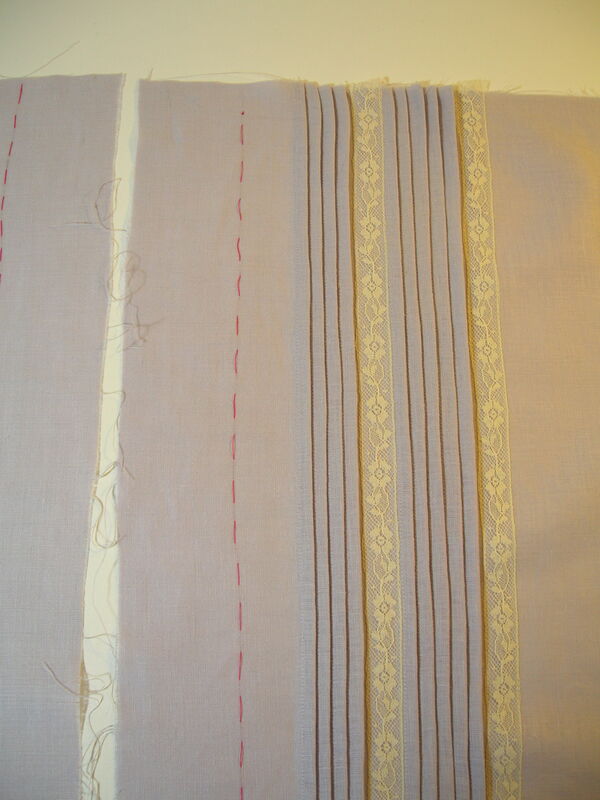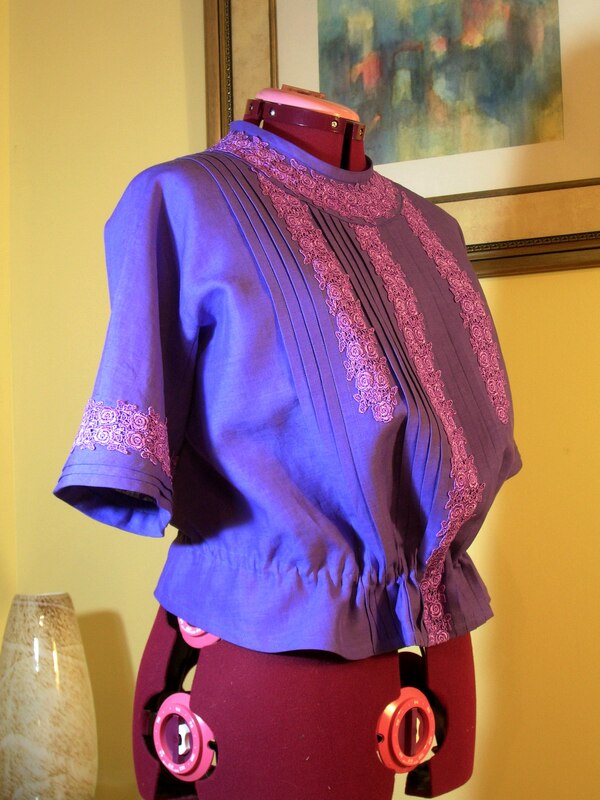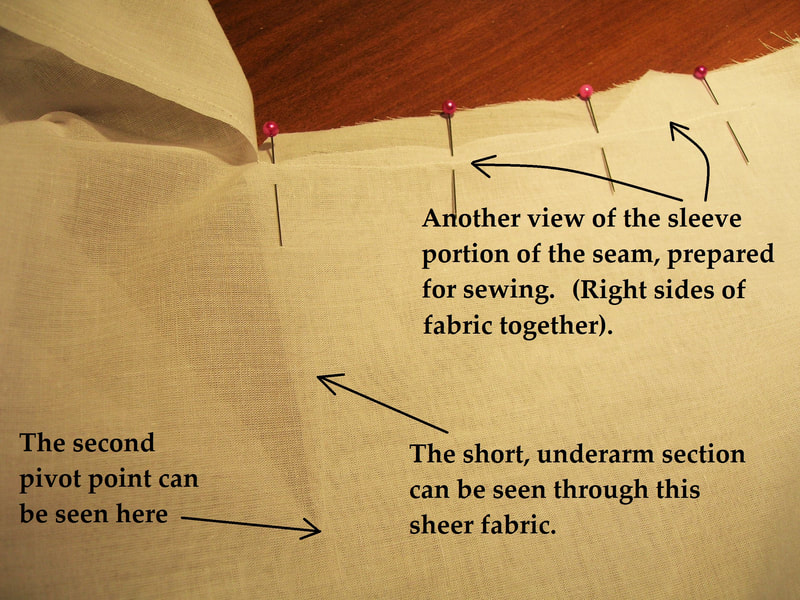 #1911-A-017, Ladies' Fancy Blouse with Lace Insertion. Section 1: How to pre-tuck the fabric before cutting out the pattern pieces. (For a guide to sewing the unique underarm/sleeve seam on this blouse, see Section 2 -- scroll down on this page) . Almost all Edwardian/early 1910's blouses that have the main portion cut in one piece (like this pattern), with fine tucks as a design feature, were pre-tucked on the flat yardage prior to the pattern pieces being cut out. This Section 1 shows the steps in preparing the pre-tucking for this blouse. Although tucking arrangements varied on blouses, you can apply this technique, with any necessary adjustments for the tucking arrangement, to any Edwardian or 1910's blouse design. The key is to do all the tucking "on the flat", before laying out and cutting the actual blouse pieces. The very first step is to start with a rectangle of fabric large enough to accommodate all the tucking you wish to have in your final blouse. For this design, I've already done those calculations for you, represented by the outline marked "Initial Cutting Frame". Follow the directions in the Sewing Instructions included in this pattern (#1911-A-017) to lay out and cut your blouse fabric from the Initial Cutting Frame. Do not yet cut the actual individual pattern pieces! The tucks are all prepared first, according to the Sewing Instructions. The annotated photos below should help you generally understand the process, but follow the written Sewing Instructions carefully, exactly in the order given, don't rely only on these pictures. Click on "Play" (top left of 1st photo) to run the slideshow below; pause at any time. Click on a thumbnail to view an individual photo. Hover right or left on the slideshow string to fast forward or reverse.
Once the Initial Cutting Frame for backs and for the front of the blouse have been fully tucked and the laces sewn on, the actual pattern pieces for Front and Back are cut from these Initial Cutting Frames, taking into account Centre Back and Centre Front when laying out the Initial Cutting Frames. Sleeve Cuffs:The Sleeve Cuffs are prepared in much the same way as the Front and Backs, with all the tucking and lace application done before sewing the Cuffs to the blouse, except in the case of the Cuffs, the necessary extra depth has already been included in the pattern (Piece #3A). Cut this piece from blouse fabric, and complete the tucks in it so that its depth matches the Guide for Finished Cuff (Piece #3B). The slideshow below shows how the prepared cuff is attached to the sleeve: Collar:The Collar is prepared in the same way as the Cuffs -- Cut the Collar from Piece #6A (Collar Tucked Section), do all the pre-tucking in that piece, then use Piece #6B as a guide for completing the Collar to the correct depth (including adding lace). The photos below show the prepared Collar being attached to the body of the Blouse: Keep in mind that all of the fancy insertion and edging lace shown in the photos here are typical for this historical era, and were the most fashionable choice for a dressy blouse, but you can omit all or any of them if you wish, making this blouse as a plainer style with tucking only. In fact, the entire blouse can be made completely plain if you wish -- with no tucking and no lace -- by skipping the Initial Cutting Frame instructions, and simply cutting out the blouse pieces themselves directly from your fashion fabric. Pattern #1911-A-017 (Section 2, Sewing the Underarm/Sleeve Seams)The seam construction of this blouse, used in almost all dressy blouses of the 1910-13 era, was a unique and masterful achievement of French design, never seen before (or in fact since that era) in garment construction. It created a shape that allowed each side of the blouse (or bodice), along with the sleeve, to be closed in one continuous seam. Not only that, but the design of this seam improved greatly on the standard "kimono" bodice, by a technique that fit the body more closely, but still dispensing with an armscye (armhole) seam. This design technique doesn't require any expert sewing skills, just a careful step-by-step method. It does help if you're able to put out of your mind everything you know about fitting a standard sleeve into the usual armhole type of construction, or sewing a "kimono" style blouse. This design is entirely different! But it's not rocket science, and I guarantee that once you've completed one of these blouses, you'll realize how straightforward yet ingenious it is. I call it the "magic blouse", because it does create an almost magical result. The seam goes up the side back, closes the underarm area, then closes the sleeve seam, all in one operation. Since this procedure is exactly the same for all these blouses, rather than repeating all the annotated photos here, just click on the link below, which will take you to the construction help photos that I've already prepared for blouse pattern #1911-A-052 (as a matter of fact, these photos were taken from the sample blouse I made from this blouse pattern #1911-A-017). Scroll down to Section 2 on the linked page. There are a lot of pictures and a lot of notations, but it's worth studying these and following the steps carefully if this is the first time you're making one of these blouses.
The most important key to success (and I can't stress this enough!) is to be sure you carefully match up the Seam Indicators provided on the printed pattern. Remember, don't expect the two sides of the sleeves or bodice to look identical or symmetrical -- they're not. Follow the steps exactly as described in the Sewing Instructions, in the exact order given, and you'll discover how clever this technique is!
0 Comments
 #1912-C-003, Girl's "Lingerie" Dress (for a 5 to 8 year old girl): This album contains one Section, with photos detailing aspects of constructing the gown and assembling the various lace portions. Although I do include these "help" photos with delivery of the PDF pattern upon purchase, I thought it would be useful to repeat them here for easy reference. This is such a lovely dress when made up, that the care and time taken in construction will be well rewarded. Click on "Play" (top left of 1st photo) to run slideshow; pause at any time. Click on a thumbnail to view an individual photo. Hover right or left on the slideshow string to fast forward or reverse.  #1912-A-040, Ladies' Fancy Tailored Suit with Contrast Collar & Trim: This album consists of just one Section, containing photos of important aspects of the construction of this suit, with annotations. Due to time constraints when the sample suits were made, I was unable to take photographs of actual construction steps, but hopefully the annotated pictures in this album will assist with construction questions. The only possibly "tricky" part of constructing this suit is the contrast satin trim on the edges of the wide collar, but this is explained in detail in the Sewing Instructions with the pattern. Follow the instructions step-by-step, and I think you'll find it makes perfect sense. Click on "Play" (top left of 1st photo) to run slideshow; pause at any time. Click on a thumbnail to view an individual photo. Hover right or left on the slideshow string to fast forward or reverse.  Section 5: This section contains two annotated photos showing details of how the waist stay (also known as "Petersham") is applied to the inside of the gown. Since this gown, unusually for a 1910's design, has no boned foundation, the Petersham is an important addition. It supports the weight of the skirt as well as ensuring that the gown stays properly positioned when worn. Click on "Play" (top left of 1st photo) to run slideshow; pause at any time. Click on a thumbnail to view an individual photo. Hover right or left on the slideshow string to fast forward or reverse.
 Section 4: The photos in this album show the method of applying the Sleeve Contrast bands on the lower Sleeve, over the lace sections. Only one Sleeve is shown. The other Sleeve is done in the same way. As with most Edwardian or 1910's construction, it's essential to follow the Sewing Instructions included with your pattern step-by-step in the exact order given. Click on "Play" (top left of 1st photo) to run slideshow; pause at any time. Click on a thumbnail to view an individual photo. Hover right or left on the slideshow string to fast forward or reverse.  Section 3: This Section shows the steps in constructing and applying the decorative lace shoulder insets and contrasting satin bands on this gown. Click on "Play" (top left of 1st photo) to run slideshow; pause at any time. Click on a thumbnail to view an individual photo. Hover right or left on the slideshow string to fast forward or reverse.  Section 2: This section shows the steps in constructing the right-hand and left opening edges of the Bodice. Note that in some photos, the "summer" version of the gown (in lightweight cream coloured silk crêpe shantung), in other pictures the "winter" version, in lightweight merlot-coloured wool. Click on "Play" (top left of 1st photo) to run slideshow; pause at any time. Click on a thumbnail to view an individual photo. Hover right or left on the slideshow string to fast forward or reverse.  #1912-A-029, Ladies' Fancy Afternoon Gown with Contrast Bands Section 1: Showing the steps in constructing the double (hidden) placket and facing in the gown front. Click on "Play" (top left of 1st photo) to run slideshow; pause at any time. Click on a thumbnail to view an individual photo. Hover right or left on the slideshow string to fast forward or reverse.  Section 3: This section contains reference photos of finished blouses made from this pattern, as a guide to how the completed garment should look. Click on "Play" (top left of 1st photo) to run slideshow; pause at any time. Click on a thumbnail to view an individual photo. Hover right or left on the slideshow string to fast forward or reverse.
 Section 2: This section sets out the steps in preparing, sewing and finishing the unique all-in-one seam in this blouse which closes the underarm, side seam and sleeve seam in one operation. Although this procedure may seem odd, or even bizarre and difficult, it is actually quite straightforward and makes sense if you follow the instructions step by step and sew carefully and slowly. This particular design feature first appeared in French garment patterns around 1909, but by 1912 was used almost exclusively for blouses and bodices that were cut all in one piece, and without a shoulder or armscye seam (a modified "kimono" cut). The obvious advantages to this clever innovation were that it drastically reduced the bulky, inelegant fit of kimono blouses under the arms, followed the line of the body more closely, and placed the side seam toward the back, slightly out of view. It was a brilliant and masterful solution to a common problem. Unfortunately, this technique could never lend itself to automated factory production or simple home-sewing (the original patterns were intended mainly for dressmakers), and so it disappeared by the mid-1910's. Please note: Many of the photos in this section were taken from Blouse #1911-A-017, but the procedure is exactly the same for this pattern #1912-A-003. Click on "Play" (top left of 1st photo) to run slideshow; pause at any time. Click on a thumbnail to view an individual photo. Hover right or left on the slideshow string to fast forward or reverse. |
OverviewThis section contains "help photos" keyed to selected 'History House' sewing patterns, to assist customers with aspects of historical construction. Archives
June 2024
Pattern List
All
|
Site powered by Weebly. Managed by Dot5Hosting






























































































































































































































































 RSS Feed
RSS Feed